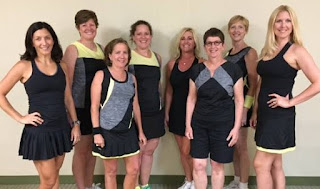Alex Millar | Towpath Tennis Member
Venus Williams states that, “Tennis is mostly mental. You win or lose the match before you even go out there.” After fifteen proud years at Towpath I have grown both professionally and personally. Creating a strong mental game on and off the court has allowed me the freedom to truly express myself as an athlete and person. As a lifelong tennis player, the most rewarding yet challenging aspect of the game is mentality. In life, its about trial and error and I find the greatest part of the sport lies in the individual challenges, whether on or off the court. In order to address the concerns I began journaling, and through that I achieved a strong and more proficient mentality.
Venus Williams states that, “Tennis is mostly mental. You win or lose the match before you even go out there.” After fifteen proud years at Towpath I have grown both professionally and personally. Creating a strong mental game on and off the court has allowed me the freedom to truly express myself as an athlete and person. As a lifelong tennis player, the most rewarding yet challenging aspect of the game is mentality. In life, its about trial and error and I find the greatest part of the sport lies in the individual challenges, whether on or off the court. In order to address the concerns I began journaling, and through that I achieved a strong and more proficient mentality.
 |
| Longtime Towpath member Alex Millar encourages play- ers to strengthen their mental game on court by journaling. |
Journaling in many ways is like playing tennis. You
are solely responsible for your performance mentally, physically, and
emotionally. You leave your mark on the court and in this case, the page. While
in tennis you trade shots with your opponent, journaling requires one to trade
the racket for the pen. Rallying your thoughts back and forth between yourself
and the page. Think of journaling as the practice match for the mental game of
life.
This is how I think, journaling daily is a mental
practice of life and of tennis. My method is to find quotes that challenge,
inspire, and motivate me to question, understand and relate them to everyday
life. It has helped me become a more critical thinker, concise writer and more
importantly a stronger tennis player. The greatest benefit of journaling is
allowing me to self-reflect on the person I am. As a new father this is
something I wanted to pass onto my children. I want them to have an
understanding of what thoughts shaped their father, and an offering the same
platform to develop the same skills I have instilled in myself.
 |
| Available for purchase at Amazon. |
Towpath will remain my home for Tennis. As a
contributor to the community I would like to extend an offer for all readers to
access my journal for personal reflection and mental practice at Towpath.
Remember to support the club that supports all in the game of tennis
in and around Northeast Ohio. Copies are $15, or 2/$20 at Towpath Tennis Center.
Another option is purchasing through Amazon though I recommend supporting the club that supports us all in our
tennis, and is foundation for the Akron and Northeast Ohio community.
 |
| Alex with his wife, Yuriko, and their 2 kids. |
(Alex Millar is a father of 2 toddlers (Anna and
Chris), and husband of 7 years to his wife Yuriko. He is a USPTA certified pro
teaching all ages for the last 12 years. Alex came up the junior ranks at
Towpath and went on to play collegiate tennis at John Carroll, as well as abroad in Japan. His next journal, On Court With Your Thoughts: Quote Guided Tennis Journaling, is slated for publication in 2018.)













